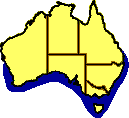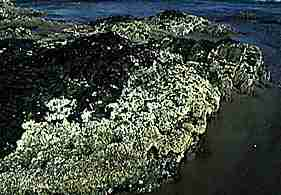|
|
Galeolaria Galeolaria caespitosa
Form:
With Galeolaria, what you first observe is the limy tubes within which the worm lives.
These may form huge colonies coating the rock surface, sometimes centimetres thick.
Inside the limy tube, the galeolaria worm body is symmetrical, with a branchial crown made up of two lobes, one holding a stalked operculum. The operculum is winged with spines. The operculum seals the tube when the animal retreats into its tube. The tentacles of the branchial crown are used as gills and as a way of capturing food.
Colour:
The calcareous tubes built by Galeolaria worms are white to grey.
Phylum: |
Annelidae |
Author: |
|
Family: |
Serpulidae |
Size: |
20-30 mm |
Distribution:
 Southern
Queensland around southern shores to Western Australia.
Southern
Queensland around southern shores to Western Australia.
Habitat:
A distinctive zone-forming species with its upper limit at the lowest neap water high-water mark. Isolated tubes may be found at any level, even above the highest tide, only being wetted by spray.
Biology:
 The
calcareous tubes built
by this worm are up to 3 cm in length.
The
calcareous tubes built
by this worm are up to 3 cm in length.
The tubes are often found singly, or as complex interwoven clumps.
These colonies form a distinctive zone at the mid tidal regions. They may be so thick and dense that they form a microhabitat for many other creatures.
Galeolaria seems to exist in very large colonies, all intertwined, or a single worm tubes. When the tubes are uncovered by water, the animal hides away and is impossible to see unless the covering tube is broken open.
References:
Galeolaria is also known as "Sydney Coral".
Bennett, I. (1987) W.J. Dakin's classic study: Australian Seashores. p.194-5, Angus & Robertson, Sydney.
Davey, K. (1998) A Photographic Guide to Seashore Life of Australia. p.38, New Holland, Sydney.
Edgar, G.J. (1997) Australian Marine Life: the plants and animals of temperate waters. p.162, Reed Books, Kew.
Quinn, G.P., Wescott, G.C. & Synnot, R.N. (1992) Life on the Rocky Shores of South-Eastern Australia: an illustrated field guide. p.33, Victorian National Parks Association, Melbourne.
Shepherd, S.A. & Thomas, I.M. (1982) Marine Invertebrates of Victoria, Pt. 1. p.291, South Australian Government Printer, Adelaide.
Underwood, A.J. & Chapman, M.G. (1993) Seashores: a beachcomber's guide. p.38, New South Wales University Press, Sydney.
Eunice
Bristle Worm
Galeolaria
Scale Worm
Peanut Worm
Home
Page
Taxonomy
Biogeography
Rocky Shores
Tidal Levels
Intertidal Zonation
Environmental Factors
Biological
Factors
Feeding Relationships
Activities
Glossary
References
 Life
on Australian Seashores
Life
on Australian Seashores
by Keith Davey (C) 2000
Learning Consultant
- Media
The University of Newcastle
email at australian_seashores@hotmail.com
Scientific Consultant: Phil
Colman
site created 01.01.98 : updated 01.04.2000

